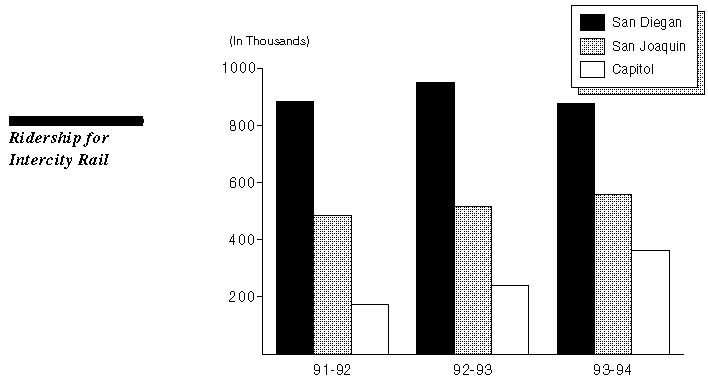
 Legislative Analyst's Office
Legislative Analyst's Office
Mass transportation includes primarily mass transit bus systems and passenger rail systems. The bulk of funding for these services comes from local resources, primarily local taxes and farebox revenues. These services are run by local or regional transit operators.

State supported intercity rail service in California is comprised of three major service routes: the San Diegan, the San Joaquin, and the Capitol. The San Diegan, the most profitable route, operates mainly between San Diego and Santa Barbara. The San Joaquin, the longest route, provides service between Oakland and Bakersfield. The Capitol route, the newest of the three routes, extends between Sacramento and San Jose.

Ridership on two intercity rail services--the San Joaquin and the Capitol--has increased slightly since 1991-92, while ridership on the San Diegan, which carries the most passengers, has remained about the same.
In general, state law requires intercity rail services to recover 55 percent of their operating expenses with fare revenues (farebox return) by the third year of operation in order to continue to receive state funds. The figure shows that while the San Diegan continues to exceed the required farebox return, returns for the San Joaquin and Capitol are currently below 55 percent.

In the case of the San Joaquin, the lower farebox return ratio is primarily the result of the addition of a fourth roundtrip between Oakland and Bakersfield. (Such expansion typically results in a reduction in the farebox return ratio until ridership increases and additional fare revenues offset the higher costs.) In the case of the Capitol, which has not yet met the statutory farebox requirement after three years of new service, the CTC has waived the requirement for one year in order to provide continued support for service on that route.
The state's seven largest transit systems serve the major urban areas in California and include (1) the Los Angeles Metropolitan Transit Authority (LAMTA), (2) Bay Area Rapid Transit District (BART), (3) San Francisco Municipal Railway (SF MUNI), (4) Alameda-Contra Costa Transit District (AC Transit), (5) Santa Clara County Transit District, (6) Sacramento Regional Transit, and (7) San Diego Regional Transit.
Transit services are subsidized by local, state, and federal funds. While passenger fares are an important source of revenue for transit agencies, local funds such as local tax measures provide the largest source of operating funds. In fact, in 1992-93, the proportion of operating funds generated from passenger fares varied among transit operators, ranging from zero percentage for San Diego Regional Transportation to about 44 percent for the Bay Area Rapid Transit (BART).

California funds traffic enforcement activities using mainly user fees, including vehicle registration fees and driver license fees. These fees are deposited in the Motor Vehicle Account and are used to support primarily the Department of Motor Vehicles and the California Highway Patrol.
Although the total amount of driving has increased by almost 54 percent since 1982, the total number of accidents has increased by only 16 percent over the same time period. However, accidents due to DUI (driving under-the-influence) have decreased by about 29 percent and the fatality rate has dropped from 2.7 to 1.6 fatalities per 100 million miles driven. These declines are due in part to more stringent traffic laws (for example, seat belt laws and DUI laws and increased enforcement).
TRAFFIC ENFORCEMENT
Vehicle and Driver License Fees Fund Traffic Enforcement

Driving Is Up . . . But Accidents and Fatalities Are Down
